
A water pump is any device for moving water. The water pump is one of the oldest and most widespread machines, and exists in an enormous variety of styles. The shaduf or shadoofW (bucket on counterweighted lever), a very primitive pump, is known to have existed since about 2000 BCE.
Some uses of water pumps include:
- Obtaining water from ground wells for drinking, cooking, and other purposes.
- Moving water in active solar heating systems.
Pumps may be powered by
- Human muscle power: hand-crank, foot-operated pedal power, reciprocating piston
- Animal power
- Mains electrical power, electric motor
- Battery power
- Solar-electric, photovoltaic collector powering electric motor
- On-site fuel-powered engine: diesel, gasoline; steam engine powered by coal, charcoal, or wood
- Wind power: Windpumps
- Water power: Ram pump, NoriaW
Windpumps[edit | edit source]
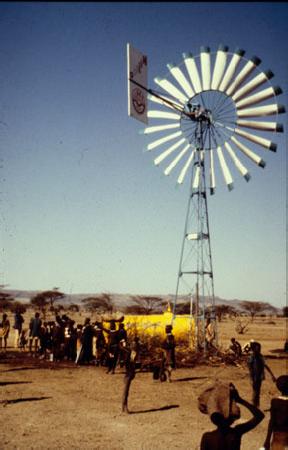
A windpump is a windmill used for pumping water, either as a source of fresh water from wells, or for draining low-lying areas of land. Once a common fixture on farms in semi-arid areas, windpumps are still used today where electric power is not available or too expensive.
The first half of the 20th saw further development, particularly a move toward propeller type wind machines for electricity production. By the 1920's 6 million windpumps were being used in the USA alone and their manufacture and use had become commonplace on every continent.But the glory of the windpump was short-lived. With the advent of cheap fossil fuels in the 1950's and 1960's and the development of pumping technology the windpump became almost obsolete in the USA.
There are manufacturers in several developing countries now producing windpumps. The uptake of wind machines for water pumping, however, has been generally very slow even though the technology is well suited to the demand of many regions of Africa, Asia and Latin America.
Treadle pumps[edit | edit source]

A treadle pump is a human-powered Pump designed to lift water from a depth of seven meters or less. A treadleW is a lever device pressed by the foot to drive a machine, in this case a pump. The treadle pump can do most of the work of a motorized pump, but costs considerably less (75%) to purchase. Because it needs no fossil fuel (it is driven by the operator's body weight and leg muscles, it can also cost less (50%) to operate than a motorized pump. It can lift five to seven cubic meters of water per hour from wells and boreholesW up to seven meters deep and can also be used to draw water from water sources such as lakes and rivers. Many treadle pumps are manufactured locally, but they can be challenging to produce consistently without highly skilled welders and production hardware.
Compared to bucket irrigation, the treadle pump can greatly increase the income that farmers generate from their land by increasing the number of growing seasons, by expanding the types of crops that can be cultivated, and improving on the quality of grown crops.
Standard treadle pumps are Suction pumps, and were first developed in the early 1980s in Bangladesh and made popular by IDE. Since then pressure pumps, a modification to the original design that means water is forced out of the pump under pressure, have also been developed and are widely in use in East Africa though KickStart. Pressure treadle pumps allow farmers to spray water and run sprinklers - saving the need for an elevated water storage tank and suction pump system.
Many NGOs (IDEW, KickStartW, Practical Action, IDEI ) have been active in developing and promoting treadle pumps, as well as student and researcher teams at universities.
Hydraulic ram pumps[edit | edit source]
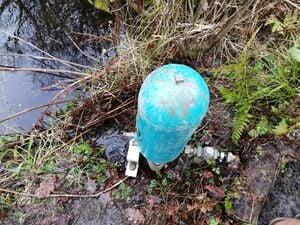
The Hydraulic Ram Pump, Hydram, or simply Ram Pump is an automatic pumping device that is capable of pumping water higher than its original source without using electricity or any other power source. It uses just two moving parts, and it is therefore mechanically very simple. This gives it very high reliability, minimal maintenance requirements and a long operation life.
The Hydraulic Ram Pump, Hydram, or simply a Ram Pump is a pump that uses the water hammerW effect from built up water pressure. Using this pressure that has been created by a water source above the pump, it is able to lift water to an elevation higher than the pump. Using just two moving parts, simple fluid mechanics and the energy within the water the Hydraulic Ram Pump is able to run without electricity or any other power source.
Papa ram pump[edit | edit source]

The Papa ram pump is a 21st century version of the traditional Hydraulic ram pumps (water pumps powered by nothing more than a flow of water), being smaller, lighter, cheaper and more efficient.
Handpumps[edit | edit source]
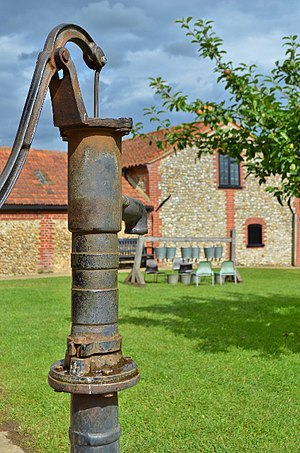
The choice of water lifters available is large and varied, making the selection of an appropriate device difficult. In America and Europe during the 19th century the design of mass-produced hand pumps evolved by trial and error rather than through scientific research and development. There are now a large number of adequate, rather than optimum, designs conceived by local manufacturers, and it is hard to know which pump is the best for each application. This brief presents an overview of the types of human-powered water-lifters available, the applications appropriate to them and their comparative advantages.
Water-lifters can be broken down into the following categories:
- Groundwater (open-well, shallow-well and deep-well pumps)
- Surface Water (shadouf, dhone, chain and washer and Archimedean screw)
Rope pumps[edit | edit source]
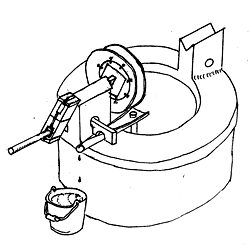
Industrial hand pumps, such as the Indian Mark II, for communal wells donated by development projects often break down after two years. If maintenance costs are the responsibility of the users, then this cost is too high when repairs prove necessary and the pump is left nonfunctional.
An alternative reliable hand pump is needed for communal and private use to supply clean drinking water and irrigation. These pumps will raise the standard of living if they are low cost, reliable and pump water effectively. Efficiency is critical to irrigate a garden in the dry season due to the relatively large amount of water involved. Such gardens provide food and increased income.
Local affordability, maintenance and good pump efficiency are required features. Local affordability means a twenty-to-hundred-fold cost reduction compared to imported industrial goods. Local maintenance is only possible when made with local resources and skills.
The pumping system should prevent contamination of drinking water by permitting the well to be sealed. This is especially true of communal wells. Industrial pumps need to be bolted onto a concrete slab positioned over the well. However, this makes the water inaccessible when the pump breaks down. Immediate maintenance on the pump or access to the well through an emergency hatch permits continuous access to life-giving water.
Coil pump[edit | edit source]
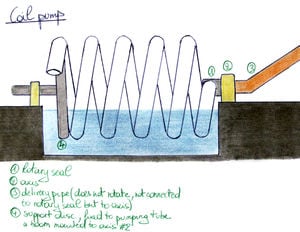
A coil pump is a low lift pump which is composed of a tube, shaped as a coil and mounted on a rotating axle powered by an engine or an animal capable of turning the axle around rapidly. Due to the rotation, water is then picked up by the tube and pumped upwards in the hose.
Noria[edit | edit source]
A noria (Arabic: ناعورة, nā‘ūra, plural نواعير nawāʿīr, from Syriac: ܢܥܘܪܐ, nā‘orā, lit. "growler") is a hydropowered scoop wheel used to lift water into a small aqueduct, either for the purpose of irrigation or to supply water to cities and villages.
Other designs[edit | edit source]
Related projects[edit | edit source]
See also[edit | edit source]
- Optimization and CFD analysis of wind-powered water pump system
- Solar (PV) water-pumping
- Comparison of pumps
- Water wells
- Windmills
- Geothermal power